Synodontis afrofischeri, known as Fischer's Victoria squeaker, the marbled Victoria squeaker, Fischer's catfish, or the Victoria synodontis, is a species of upside-down catfish native to Kenya, Rwanda, Tanzania and Uganda. It was first described by German zoologist Franz Martin Hilgendorf in 1888, based upon a holotype discovered in Lake Victoria. The specific name "afrofischeri" is in honor of the German researcher Dr. Gustav Fischer, a German explorer of Africa.
Synodontis ruandae is a species of upside-down catfish native to Rwanda, Burundi, and Tanzania where it is found in the Kagera River system. It was first described by Belgian ichthyologist Hubert Matthes in 1959, based upon holotypes discovered in the Kagera River at Rusumo, Rwanda. The specific name "ruandae" is derived from its type locality, Rwanda.
Synodontis acanthoperca, known as the scissortail synodontis, is a species of upside-down catfish native to Gabon where it occurs in the Ogowe River. It was first described by John Patrick Friel & Thomas R. Vigliotta in 2006, based upon a holotype discovered in the Ogooué River in Gabon, at and below the Rapids of Massoukou. The specific name "acanthoperca" comes from the Latinized combination of the Greek word acantha, meaning "thorn", and the Latin opercul, meaning cover or lid, which refers to the pronounced spines that develop on the operculum of mature males.
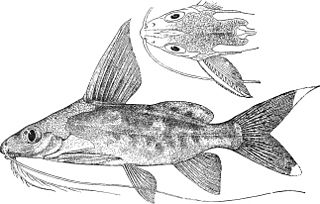
Synodontis alberti, the bigeye squeaker, Albert's syno, bigspotted squeaker, or high-fin synodontis, is a species of upside-down catfish native to the Congo Basin of Cameroon, the Democratic Republic of the Congo and the Republic of the Congo. It was originally described in 1891 by Belgian ichthyologist Louise Schilthuis after its discovery in the Malebo Pool of the Congo River.

Synodontis batesii is a species of upside-down catfish native to rivers of Cameroon, the Democratic Republic of the Congo, Equatorial Guinea and Gabon. It was first collected by G. L. Bates and described by Belgian-British zoologist George Albert Boulenger in 1907, based upon holotypes discovered in the Dja River, near Bitye in Cameroon. The specific name "batesii" refers to the name of the collector of the first specimen.

Synodontis congicus is a species of upside-down catfish native to the Democratic Republic of the Congo and the Republic of the Congo where it occurs in the upper and middle Congo Basin. It was first described by Belgian ichthyologist Max Poll in 1971. The first specimen was found near the town of Gangala-na-Bodio, Democratic Republic of the Congo, in the Dungu River. The meaning of the specific name "congicus" is "From the Congo".

Synodontis courteti is a species of upside-down catfish that is native to the countries of the Niger and Chad Basins. It has been recorded in Cameroon, Chad, Ghana, Guinea, Mali, Niger, and Nigeria. It was first described by French zoologist Jacques Pellegrin in 1906, from specimens collected in the Chari River, Chad. The species name courteti is named after M. Courtet, member of the "Mission Chari-Lac Chad".
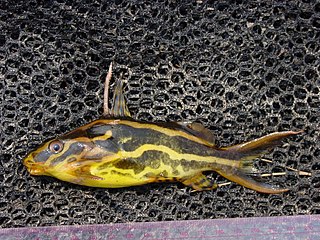
Synodontis flavitaeniatus, known as the orangestriped squeaker, the chocolatestriped squeaker, the yellowstriped squeaker, and the pyjama Syno, is a species of upside-down catfish native to the Democratic Republic of the Congo and the Republic of the Congo where it is found in the lower and central Congo Basin. It was first described by Belgian-British zoologist George Albert Boulenger in 1919. The holotype was collected from the Ruki River at Eala, in the Democratic Republic of the Congo. The meaning of the specific name "flavitaeniatus" is "yellow stripes".

Synodontis greshoffi is a species of upside-down catfish native to the Congo Basin of Cameroon, the Democratic Republic of the Congo and the Republic of the Congo. It was first collected by M.A. Greshoff in Pool Malebo on the upper Congo River, and the species was named for him by the author of the first paper written about the species, Belgian ichthyologist Louise Schilthuis, in 1891.
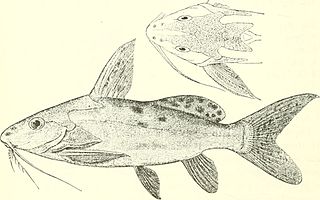
Synodontis haugi, known as the black synodontis, is a species of upside-down catfish native to Gabon where it is found in the Ogowe River basin. It was first collected by M.E. Haug and described by French zoologist Jacques Pellegrin in 1906, based upon a holotype discovered in the Ogooué River, near Ngomo, Gabon. The specific name "huagi" is a tribute to the original collector of the species.
Synodontis marmoratus is a species of upside-down catfish that is native to Cameroon where it is found in the Sanage and Nyong Rivers. It was first described by Swedish zoologist and conservationist Einar Lönnberg in 1895, from a specimen collected from Bonge, Cameroon.

Synodontis notatus, known as the onespot squeaker, the one-spot synodontis, or the domino syno, is a species of upside-down catfish native to the Congo Basin of the Democratic Republic of the Congo, and the Republic of the Congo. It was first described by French zoologist Léon Vaillant in 1893. The specific name "notatus" comes from the Latin word for "marked", as with a spot.
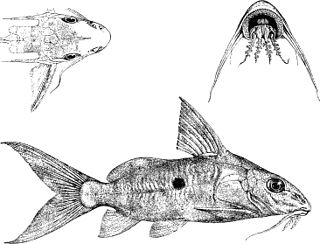
Synodontis nummifer, known as the two spot synodontis, is a species of upside-down catfish native to the Congo Basin of Cameroon, the Democratic Republic of the Congo and the Republic of the Congo. It was first described by the Belgian-British zoologist George Albert Boulenger in 1899, based upon a holotype discovered in Léopoldville, Belgian Congo. The specific name "nummifer" comes from the Latin for "to bear a coin", which refers to the large spots on its sides.

Synodontis ocellifer, known as the ocellated synodontis, is a species of upside-down catfish native to the rivers of northern and western Africa. It has been reported in 10 countries, including Burkina Faso, Cameroon, Chad, Gambia, Ghana, Guinea, Mali, Niger, Nigeria, and Senegal. It was first described by Belgian-British zoologist George Albert Boulenger in 1900, from specimens collected in Kunchow Creek, in Gambia. The species name ocellifer comes from the Latin word ocellus, meaning "eye", and the Latin word ifer, meaning "to carry", which refers to the black spots, possibly with white centers found on the sides.
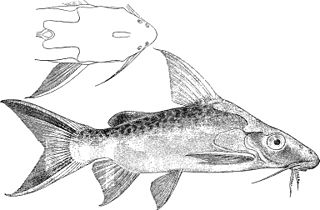
Synodontis pleurops, known as the Congo squeaker, the bigeye squeaker, or the bug eyed synodontis, is a species of upside-down catfish native to the upper Congo Basin of Cameroon, the Democratic Republic of the Congo and the Republic of the Congo. It was first described by the Belgian-British zoologist George Albert Boulenger in 1899, based upon a holotype discovered at the Boyoma Falls, in the Democratic Republic of the Congo.
Synodontis polyodon is a species of upside-down catfish native to Gabon where it occurs in the Ogowe River basin. It was first described by French zoologist Léon Vaillant in 1895, based upon a holotype discovered in the Ogooué River, near Adouma, Gabon. The specific name "polyodon" comes from the Greek words poly, meaning "many" and odon, meaning "tooth", referring to the many teeth in this species.

Synodontis robbianus, known as the russet synodontis, is a species of upside-down catfish that is native to Nigeria where it is found in the Cross and lower Niger Rivers. It was first described by John Alexander Smith in 1875, from specimens collected in the Calabar River, Nigeria. The species name robbianus is named after Rev. Alexander Robb, a Scottish missionary, who collected the original species samples.

Synodontis schoutedeni, known as the yellow marbled Synodontis, is a species of upside-down catfish native to the Congo Basin of the Democratic Republic of the Congo and the Republic of the Congo. It was first described by Belgian ichthyologist Lore Rose David in 1936, based upon a holotype discovered in Basongo, in what is now the Democratic Republic of the Congo. The specific name "schoutedeni" is named after the Belgian zoologist Henri Schouteden.

Synodontis woosnami, known as the Upper Zambezi squeaker, or bubblebarb squeaker, is a species of upside-down catfish that is native to Angola, Botswana, Namibia, Zambia and Zimbabwe where it is found in the upper Zambezi and Okavango River basins and the Cunene River. It was first described by British-Belgian zoologist George Albert Boulenger in 1911, from a specimen collected in the Okavango River in the Lake Ngami district of Botswana. The species name woosnami is derived from R. B. Woosnam, the collector of the first specimen.
Synodontis woleuensis is a species of upside-down catfish native to Equatorial Guinea and Gabon. It was first described in 2008 by American zoologists John P. Friel and John P. Sullivan. The original holotypes were collected in the Woleu-Ntem Province, Gabon. The specific name "woleuensis" is derived from the Woleu River, where the specimens were originally collected.














